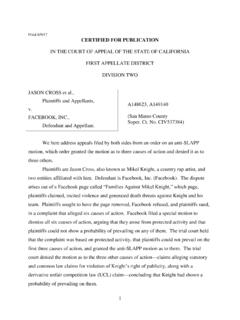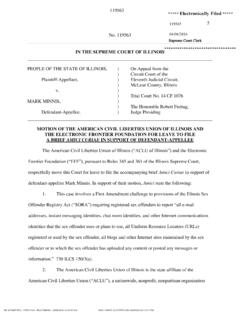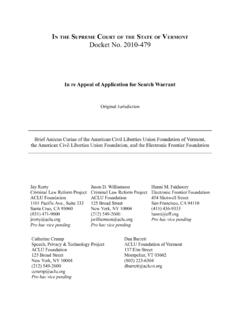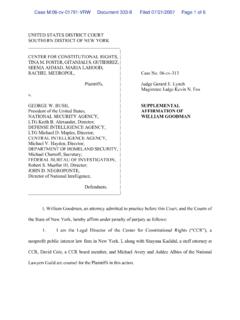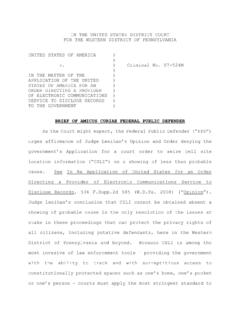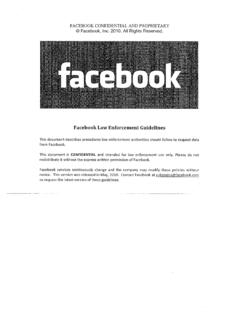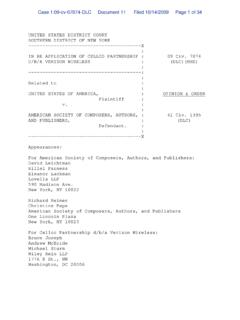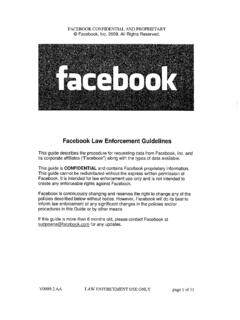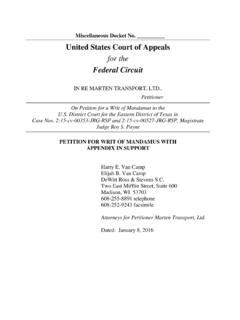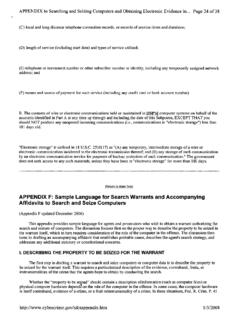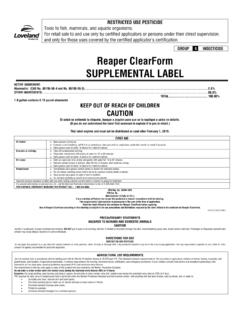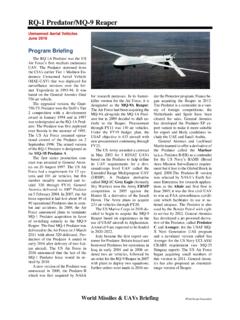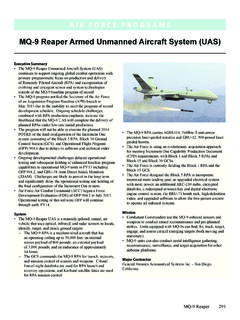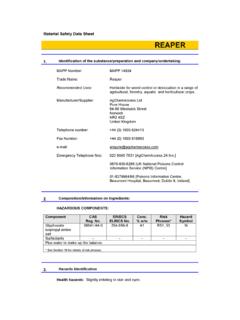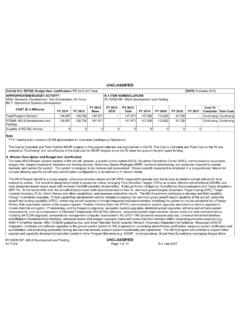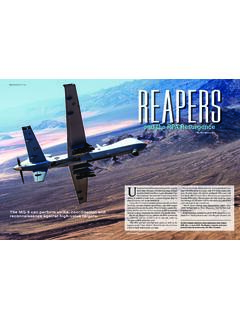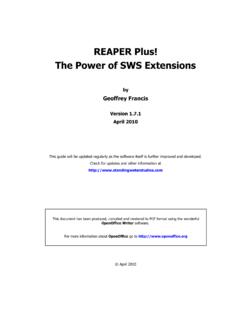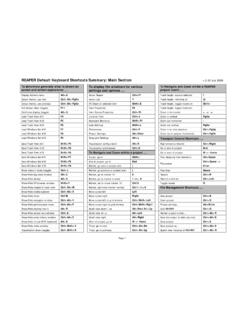Transcription of Operational Risk Analysis of Predator/Reaper Flight ...
1 1 Operational Risk Analysis of Predator/Reaper Flight Operations in a Corridor between Cannon AFB and Melrose Range (R-5104A) Executive Summary This assessment was prepared to support the 27th Operations Group application for a Certificate of Authorization (COA) in support of Air Force Special Operations Command (AFSOC) Predator/Reaper Unmanned Aircraft Systems (UAS) operations at Cannon AFB, NM. AFSOC took control of Cannon AFB in October of 2007 and this expansion offers Special Operators a western base to enhance support for operations in the Pacific theater and meet the objectives of our global defense posture. The predator and Reaper are invaluable DoD assets in the Global War on Terrorism and it is of utmost importance to the National Security that our pilots be able to train and maintain proficiency. This document includes a MQ-1 ground observer capability demonstration (attachment 1), a UAV FY 2008 hazardous aircraft traffic report spreadsheet, and a Cannon AFB aircraft control radar log of all observed radar traffic operating in the vicinity of the proposed corridor.
2 predator operations within Cannon s Class D airspace are anticipated to begin in March 2009. A COA (ASN-2008-CSA-10) has been approved by the Federal Aviation Administration (FAA) for the predator operations within the Cannon AFB Class D airspace. Reaper operation dates at Cannon are still to be determined due to the on-going priorities overseas. The next step is to provide pilots and crew members a proposed corridor between Cannon AFB and R-5104 so that they can access needed airspace for realistic train the way you fight continuation and proficiency training. To that end, a corridor has been designed (figure 1) and a risk assessment was completed in accordance with AFI 90-901, Operational Risk Management, to present data to show that AFSOC has sufficiently mitigated the risk of a potential collision between an unmanned aircraft and an uncooperative (no transponder) aircraft.
3 The Air Force six-step ORM process is a sound methodology for risk assessment, and the process provides formal documentation of acceptance of residual risk at the appropriate level. UAS operations within the 27th Special Operations Wing (SOW) will soon expand to include a second UAS, the MQ-9 Reaper. Historical, empirical data referenced in this assessment relied on MQ-1 predator and available MQ-9 data. Since MQ-1 and MQ-9 operations are comparable, recommendations and conclusions here apply to these unmanned aircraft system airframes operated by the 27th SOW. The USAF has applied risk management philosophy and methods to predator operations intuitively and experientially for years. Declining mishap rates in the ground, Flight and weapons arenas are the result of these risk management efforts. Applying a structured ORM process allows greater and more consistent results by using a systematic method rather than relying solely on experience.
4 AFSOC convened subject matter experts from the staff along with FAA participation and representation from the 27th SOW. The group reviewed planned predator operations in the proposed corridor using a variety of approved ORM tools listed in AFMAN 90-902, Operational 2 Risk Management Guidelines and Tools, to complete a thorough assessment which included all six steps required in the ORM process: Identify the Hazards: apply appropriate hazard identification techniques to identify hazards associated with the proposed operation or activity. Assess the Risk: apply quantitative or qualitative measures to determine the probability and severity of adverse outcomes associated with exposure to identified hazards. Analyze Risk Control Measures: evaluate specific strategies and controls that reduce or eliminate risk. Effective mitigation measures reduce one of the three components (probability, severity or exposure) of risk.
5 Make Control Decisions: choose the best control or combination of controls based on the Analysis of overall costs and benefits, and formally accept any residual risk. Implement Risk Controls: once control measures have been selected, an implementation strategy must be developed and carried out. Supervise and Review: leaders at every level must fulfill their respective roles in ensuring controls are sustained over time; once controls are in place, the process must be periodically re-evaluated to ensure its effectiveness. This ORM assessment resulted in the following conclusions: 1. AFSOC is able to safely conduct predator Flight operations within the proposed corridor. 2. AFSOC has implemented mitigating actions to address the shortfalls of unmanned aircraft with respect to 14 CFR Part 91. 3. The risk mitigation in place results in a residual risk level of Medium in accordance with governing Air Force guidance.
6 This equates to a level of extremely remote in accordance with FAA guidance. The primary hazards contributing to the risk of mid-air collision and loss of aircraft or loss of life have been considered and mitigated. In accordance with guidance in AFI 90-901 and the AFSOC supplement, this level of risk may be accepted at the Squadron Command level. This assessment is prepared for AFSOC/A3 review to document command acceptance and approval of the ORM process. 4. predator operations must be periodically reviewed to verify that previously instituted mitigation measures are validated and remain effective. 5. predator operations must be periodically reviewed when technological solutions become available to further mitigate risk. Technological solutions should not be mandated, but systematically reviewed to determine when it is economically feasible and mission supportive.
7 3 6. The implemented mitigation measures support the 27th OG application for a COA in support of AFSOC operations in a corridor between Cannon AFB and R-5104A. Figure 1. Proposed Corridor. Hazard Analysis ACTIONS FOR STEP 1 IDENTIFY THE HAZARDS Hazard identification is the foundation of the ORM process. Hazards were identified as associated with the following three categories IAW AFMAN 90-902: Mission Degradation, Personal Injury or Death, and Property Damage. This Analysis focused on hazards associated with potential mid-air collision between an unmanned aircraft and both cooperative and non-cooperative aircraft within a defined corridor between Cannon AFB and R-5104A. Formal hazard identification tools included Operational Analysis and Preliminary Hazard Analysis , and Logic Diagrams. Mission/Task Analysis was accomplished through a review of current and planned Cannon AFB predator operations, as well as a thorough review of mishap data from the FAA, NTSB, and Air Force Safety Automated System (AFSAS).
8 Current guidance was reviewed including applicable Air Force Instructions, FAA regulations, operating instructions, ACTION 3: LIST CAUSES ACTION 2: LIST HAZARDS ACTION 1: MISSION/TASK Analysis 4 checklists, briefing guides, syllabi, FCIFs, NOTAMs, and policy letters. Major mission tasks were grouped into subsets based on mission phase and charted in time sequence with hazards, and factors that could generate hazards, identified based on the deficiency to be corrected and mission and system requirements. This yielded a listing of inherent hazards or adverse conditions which could contribute to the possibility of a midair collision. Analysis also examined interfaces between or among individual elements. Major mission phases included the mission planning phase, takeoff through departure, enroute maneuvering, return to base, traffic pattern operations, and post- Flight .
9 Following the Operational Analysis , the group completed a Preliminary Hazard Analysis (PHA) to consider risk in the major mission phases and to prioritize follow-on hazard analyses. The PHA produced three groups of hazards for follow on study divided into mission planning hazards, external hazards, and in- Flight hazards as summarized in table 1 below. Preliminary Hazard Analysis Mission Planning Hazards External Hazards In- Flight Hazards 1. UAS systems failures 1. Weather/Wind/Icing 1. Conflict with other traffic 2. Improper Command link settings 2. Improper Route Planning/Scheduling 2. UAS Mechanical failure 3. Improper Communication system settings 3. Failure of Air Traffic Control Radar 3. UAS Software failure 4. Inadequate Information display systems 4. Failure of Air Traffic Control Communications 4. Failure of Command Link 5. Improper Mission Plan development 5.
10 Conflict during execution of lost link procedures 6. Position error Table 1: Preliminary Hazard Analysis From the PHA, hazards which could contribute to a midair collision were mapped into a logic diagram to illustrate the connectivity and linkages between hazards (see Figure 2). Results of the hazard Analysis were reviewed using the 5 M model as a framework. This team focused on a successful predator mission and potential failures that could result in a midair collision. The 5-M s stand for Man, Machine, Media, Management, and Mission. Man, Machine, and Media interact to complete a successful Mission. Management provides the procedures and rules governing the interactions between the various elements. Each element provides opportunities to manage risk. Groups of machine related systems failures (A) and man related pilot procedure errors (B) are common to both unmanned and manned aircraft in a potential mid-air collision scenario.
